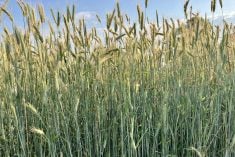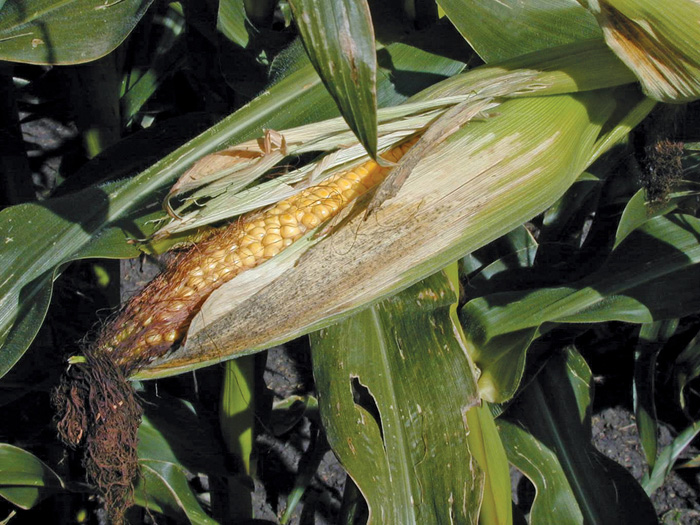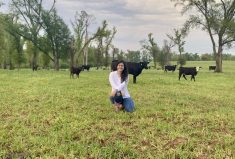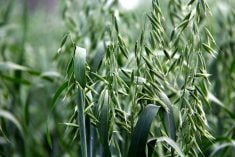While high nitrates in feeds are more commonly seen in frost-touched plants, Saskatchewan Agriculture staff have been seeing high levels in drought-stressed crops this summer, highlighting the importance of feed testing this fall.
“We’ve seen a really wide variety of test results come in, some as high as five per cent (for nitrates), which is incredibly difficult to manage, especially if you don’t know that in advance,” says Jenay Werle.
Werle, a livestock and feed specialist with Saskatchewan Agriculture in Yorkton, says whether the feed is in the form of bales, silage or dry feed, it’s important to gather representative samples for feed testing.
Read Also

Treaty Land Sharing Network expands reach in Saskatchewan and Alberta
The Treaty Land Sharing Network, which connects land holders with First Nations and Metis people, has expanded since it began in 2018
“There can be such a variety in quality in a drought year that even if they’ve made the same hay on the same quarter, year after year, things might be different than expected this year. So I would encourage producers to test even if they’re not feeding anything out of the ordinary.”
Sampling bales
“No matter what type of bale that you have out there, always take the sample between the twines so that you’re going across the flakes or going across the layers,” says Barry Yaremcio, formerly a beef and forage specialist with Alberta Agriculture. Yaremcio is now an independent ruminant nutritionist and production management consultant based in Stettler, Alta.
Both Yaremcio and Werle recommend using a core sampler rather than grabbing handfuls of hay, as the core sampler is much more accurate. Pulling out handfuls of hay will add up to a big difference in quality, says Yaremcio, affecting how the ration is formulated and how much is spent on supplements. To illustrate how sampling can affect quality, Yaremcio forwarded grab vs. core sampling results, taken from the same bales that were at the University of Alberta dairy unit in the late ’80s. Werle adds the core sampler should be inserted at a 90-degree angle to get a good cross-section.
Both Werle and Yaremcio recommend sampling from several bales. Yaremcio recommends pulling 20 samples per feed type, while Werle suggests 10 to 15. The important thing is to sample from more than a couple of bales, Werle says, as if a producer happens to pick a couple of really good or bad bales, that could skew the results.
Producers buying hay from far afield may see some regional differences in feed quality. For example, Yaremcio notes that forages sourced from Dawson Creek to Prince George tend to be lower in protein. In Saskatchewan, Werle says, people generally assume feed will be selenium-deficient.
If producers are hauling in feed from elsewhere by the semi-load, it’s worth trying to sample from those regions, Werle says. But if a person is buying 10 bales here and there, she suggests mixing them. Yaremcio says producers might want to track feed test results by region if they want to get a better idea of where to purchase from or what to watch for next year.
But both note it’s more important to focus on overall nutrition. Make sure you know what you’ve got in your feedyard and what you’ll be supplying to your animals, says Yaremcio.

Silage, Grain and pellets
“What’s important is you’re not drawing all your samples from one small area of the field, as levels can change depending on topography and moisture content and even fertilization — if there’s a lot of manure applied in one area and not another,” says Werle.
Werle recommends collecting samples from different areas of the pit. Producers can use a probe to take samples from the top. Also take samples from the face.
Yaremcio recommends using a core sampling tool if the pit hasn’t been opened. But if the pile has been opened, he suggests taking samples from across the face.
“Before you take the sample, rub the surface to get rid of any loose material because that stuff will be drier … than the rest of the material,” he says. Yaremcio recommends working in a “W” or “M” pattern across the face to get a representative sample.
Yaremcio says it’s easiest to collect samples while the pit is being filled, and it allows farmers and ranchers to formulate rations earlier in the year.
To collect samples while filling the pit, use a 20-litre pail with a lid. Take small handfuls from every two or three loads.Once you’ve dropped them into the pail, put the lid back on to keep in moisture. At the end of the day, mix the samples and fill about half a bread bag or a large Ziplock bag.
“Squeeze out the air, seal it and throw it in the freezer,” says Yaremcio. If the silage is well-packed and sealed, it should be almost identical to the quality of material coming from the pit.
Werle says any fresh feed sample that hasn’t been cured or dried down should be frozen before being sent for analysis. “A wet forage sample in a plastic bag won’t do the results any favours when they come back.”
Producers can also grab handfuls of cereal grains as the truck is being unloaded to get a representative sample, says Yaremcio. He suggests sending half to three-quarters of a litre of material to the lab for testing.
For those buying pelleted feed from a company, Yaremcio recommends collecting a sample as the truck’s being unloaded. “Keep that on hand, just in case. You never know when there might be a problem, and if you don’t have a sample, you’ve got nothing to go on.”
Sampling from the field
Producers can also clip samples from crops in the field, which can work well when cattle will be grazing the crop. Before clipping the plants, think about how much of the plant will be harvested, as plants typically accumulate nitrates in the bottom third of the stem. The bottom of the stem is also the lowest quality.
“With animals, if you’re going to be grazing it, you want to cut it to the amount you think the animals will graze it down to,” says Werle.
Cattle will likely clip immature plants closer to the ground, Werle adds. “So it’s a bit of a judgement call. But because the majority of that nitrate is in the lower part, you don’t want to skew your results by including that high-nitrate area into something that may not be fed.”
Yaremcio suggests leaving the bottom four inches or so of the stalk when clipping plants, as that’s the lowest cattle will eat. If the plants will be swath-grazed and are already in the swath, he suggests picking three or four stems from 20 different locations in the field, and submitting it as a composite sample. Choose plants from the middle of the swath, as that should be more representative, he adds.
Werle also suggests sampling from various spots within the field. Take samples from high spots, low spots, close to water sources, close to fencelines and randomly throughout the field, she adds.
Sampling canola
Whether it’s a mature crop or regrowth, canola can be a good feed, Yaremcio and Werle agree. It has the potential for high protein and TDN of around 65 per cent, Yaremcio notes. But whether it’s going to be grazed, baled or silaged, it needs to be tested.
Like many crops, canola can have high nitrates. All brassicas should also be tested for sulphur levels. Sulphur in feed can interact with sulphates in water, highlighting the need to test water as well. High sulphur levels can interfere with the animal’s ability to absorb copper, creating a deficiency, or cause polio.
Producers should also watch for high molybdenum levels in canola. Molybdenum can tie up copper. Yaremcio is finding it’s not just Manitoba with high molybdenum levels — he’s seeing feed tests from outside that province with high levels.
“There are pockets in the grey wooded soil zone that also have the high moly levels,” he says.
Werle also recommends ranchers be aware of any crop protection products applied to the crop. Check whether that product has been registered for livestock feed.
Whatever producers have on hand for feed this fall and winter, testing is important, says Werle.
“Especially in a year like this, where inventory is low, understanding the quality of the forages producers have on hand will be the best thing that they can do to manage those feedstocks through the whole winter.”
















